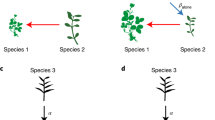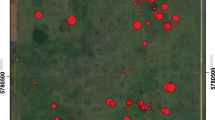Abstract
Invasive plants are an economic problem and a threat to the conservation of natural systems. Escape from natural enemies might contribute to successful invasion1, with most work emphasizing the role of insect herbivores2,3,4; however, microbial pathogens are attracting increased attention5. Soil biota in some invaded ecosystems may promote ‘exotic’ invasion6,7,8,9, and plant–soil feedback processes are also important. Thus, relatively rare species native to North America consistently demonstrate negative feedbacks with soil microbes that promote biological diversity10, whereas abundant exotic and native species demonstrate positive feedbacks that reduce biological diversity10. Here we report that soil microbes from the home range of the invasive exotic plant Centaurea maculosa L. have stronger inhibitory effects on its growth than soil microbes from where the weed has invaded in North America. Centaurea and soil microbes participate in different plant–soil feedback processes at home compared with outside Centaurea's home range. In native European soils, Centaurea cultivates soil biota with increasingly negative effects on the weed's growth, possibly leading to its control. But in soils from North America, Centaurea cultivates soil biota with increasingly positive effects on itself, which may contribute to the success of this exotic species in North America.
This is a preview of subscription content, access via your institution
Access options
Subscribe to this journal
Receive 51 print issues and online access
$199.00 per year
only $3.90 per issue
Buy this article
- Purchase on Springer Link
- Instant access to full article PDF
Prices may be subject to local taxes which are calculated during checkout


Similar content being viewed by others
References
Crawley, M. J. Natural Enemies: the Population Biology of Predators, Parasites, and Diseases (Blackwell Science, Oxford, UK, 1992)
Louda, S. M., Pemberton, R. W., Johnson, M. T. & Follet, P. A. Non-target effects: the Achilles heel of biological control? Annu. Rev. Entomol. 48, 365–396 (2003)
Goeden, R. D. & Andres, L. A. Handbook of Biological Control (eds Bellows, T. S. & Fisher, T. W.) Ch. 34 (Academic, New York, 1999)
McEvoy, P. & Coombs, E. M. Biological control of plant invaders: regional patterns, field experiments, and structured population models. Ecol. Appl. 9, 387–401 (1999)
Mitchell, C. G. & Power, A. G. Release of invasive plants from fungal and viral pathogens. Nature 421, 625–627 (2003)
Richardson, D. M., Allsopp, N., D'Antonio, C. M., Milton, S. J. & Rejmánek, M. Plant invasions—the role of mutualisms. Biol. Rev. 75, 65–93 (2000)
Simberloff, D. & Von Holle, B. Positive interactions of nonindigenous species: invasional meltdown? Biol. Invas. 1, 21–31 (1999)
Marler, M. M., Zabinski, C. A. & Callaway, R. M. Mycorrhizae indirectly enhance competitive effects of an invasive forb on a native bunchgrass. Ecology 80, 1180–1186 (1999)
Callaway, R. M., Newingham, B., Zabinski, C. A. & Mahall, B. E. Compensatory growth and competitive ability of an invasive weed are enhanced by soil fungi and native neighbors. Ecol. Lett. 4, 1–5 (2001)
Klironomos, J. Feedback with soil b iota contributes to plant rarity and invasiveness in communities. Nature 417, 67–70 (2002)
Packer, A. & Clay, K. Soil pathogens and spatial patterns of seedling mortality in a temperate tree. Nature 440, 278–281 (2000)
Burdon, J. J. The structure of pathogen populations in natural plant communities. Annu. Rev. Phytopathol. 31, 305–348 (1993)
Van der Putten, W. H., Vet, L. E. M., Harvey, J. A. & Wäckers, F. L. Linking above and belowground multitrophic interactions of plants, herbivores, pathogens and their antagonists. Trends Ecol. Evol. 16, 547–551 (2001)
Holah, J. C. & Alexander, H. M. Soil pathogenic fungi have the potential to affect the coexistence of two tall-grass prairie species. J. Ecol. 87, 598–606 (1999)
Brundrett, M. Mycorrhizas in natural ecosystems. Adv. Ecol. Res. 21, 171–313 (1991)
Crowley, D. E., Yant, Y. C., Reid, C. P. P. & Szaniszlo, P. J. Mechanisms of iron acquisition from siderophores by microorganisms and plants. Plant Soil 130, 179–198 (1991)
Newsham, K. K., Fitter, A. H. & Watkinson, A. R. Root pathogenic and arbuscular mycorrhizal fungi determine fecundity of asymptomatic plants in the field. J. Ecol. 82, 805–814 (1994)
Bever, J. D., Westover, K. M. & Antonovics, J. Incorporating the soil community into plant population dynamics: the utility of the feedback approach. J. Ecol. 85, 561–573 (1997)
Bever, J. D. Negative feedback within a mutualism: host-specific growth of mycorrhizal fungi reduces plant benefit. Proc. R. Soc. Lond. B 269, 2595–2601 (2002)
Van der Putten, W. H., Van Dijk, C. & Peters, B. A. M. Plant-specific soil-borne diseases contribute to succession in foredune vegetation. Nature 362, 53–56 (1993)
Bever, J. D. Feedback between plants and their soil communities in an old field community. Ecology 75, 1965–1977 (1994)
Van der Putten, W. H. & Peters, B. A. M. How soil-borne pathogens may affect plant competition. Ecology 78, 1785–1795 (1997)
Bais, H. P., Walker, T. S., Stermitz, F. R., Hufbauer, R. S. & Vivanco, J. M. Enantiomeric-dependent phytotoxic and antimicrobial activity of (± )-catechin. A rhizosecreted racemic mixture from spotted knapweed. Plant Physiol. 128, 1173–1177 (2002)
Angspurger, C. K. Pests, Pathogens, and Plant Communities (eds Burdon, J. J. & Leather, S. R.) Ch. 3 (Blackwell Scientific, Oxford, 1990)
Streitwolf-Engel, R., Boller, R., Weimken, A. & Sanders, I. R. Clonal growth traits of two Prunellax species are determined by co-occurring arbuscular mycorrhizal fungi from a calcareous grassland. J. Ecol. 85, 181–191 (1997)
Young, N. R. & Mytton, L. R. The response of white clover to different strains of Rhizobium trifolii in hill land reseeding. Grass Forage Sci. 38, 13–39 (1983)
Eom, A. & Hartnett, D. C. Host plant species effects on arbuscular mycorrhizal fungal communities in tallgrass prairie. Oecologia 122, 435–444 (2000)
van der Heijden, M. G. A. et al. Mycorrhizal fungal diversity determines plant biodiversity, ecosystem variability and productivity. Nature 396, 69–72 (1998)
Acknowledgements
We thank E. Corcket and R. Michalet for assistance with locating and identifying C. maculosa populations in Europe, and K. Feris for assistance with denaturing gradient gel electrophoresis data analysis. Our research on soil microbes and plant invasion is supported by NSF, USDA, the Andrew W. Mellon Foundation and The University of Montana.
Author information
Authors and Affiliations
Corresponding author
Ethics declarations
Competing interests
The authors declare that they have no competing financial interests.
Supplementary information
Supplementary Information
Supplementary figures and methods for DGGE analysis. (PDF 65 kb)
Rights and permissions
About this article
Cite this article
Callaway, R., Thelen, G., Rodriguez, A. et al. Soil biota and exotic plant invasion. Nature 427, 731–733 (2004). https://doi.org/10.1038/nature02322
Received:
Accepted:
Issue Date:
DOI: https://doi.org/10.1038/nature02322
This article is cited by
-
Invasive and native plants show different root responses to feedback-mediated soil heterogeneity
Plant and Soil (2024)
-
Significant changes in soil microbial community structure and metabolic function after Mikania micrantha invasion
Scientific Reports (2023)
-
Negative plant-soil feedbacks disproportionally affect dominant plants, facilitating coexistence in plant communities
npj Biodiversity (2023)
-
Continuous Replanting Could Degrade Soil Health in Short-Rotation Plantation Forestry
Current Forestry Reports (2023)
-
Temporal dynamics of plant−soil feedback and related mechanisms depend on environmental context during invasion processes of a subtropical invader
Plant and Soil (2023)
Comments
By submitting a comment you agree to abide by our Terms and Community Guidelines. If you find something abusive or that does not comply with our terms or guidelines please flag it as inappropriate.



